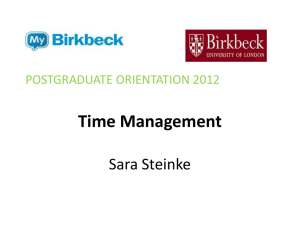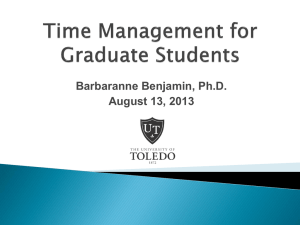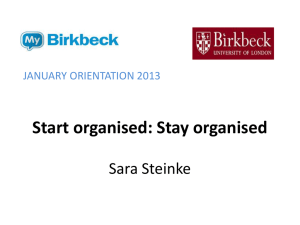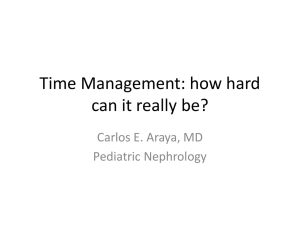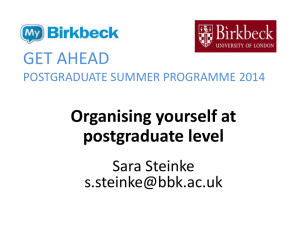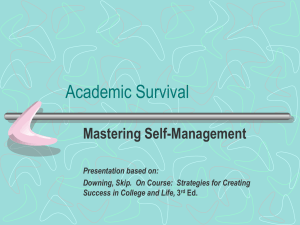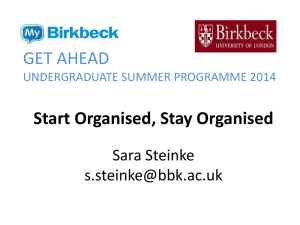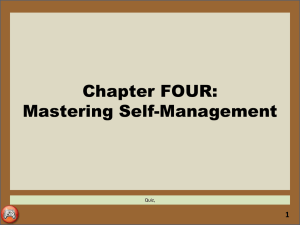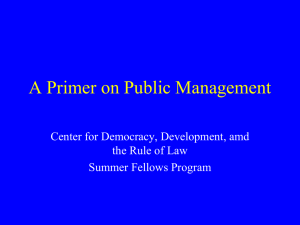Managing Time and Workload
advertisement
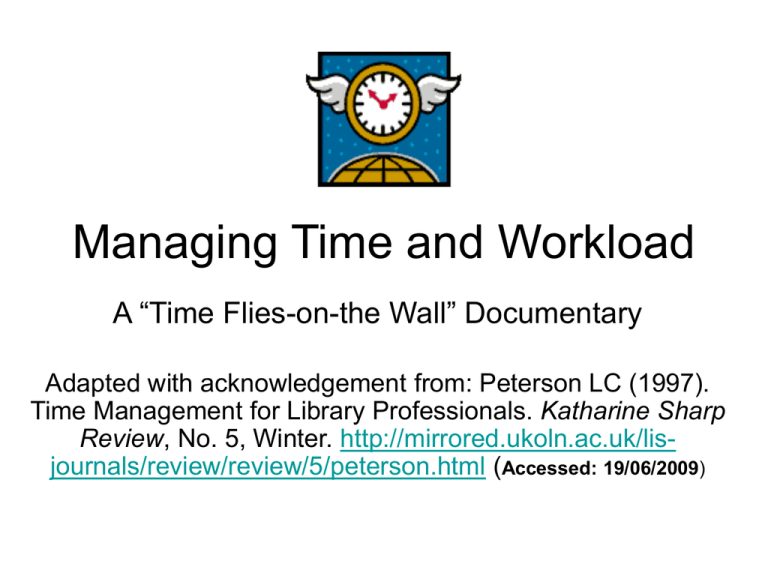
Managing Time and Workload A “Time Flies-on-the Wall” Documentary Adapted with acknowledgement from: Peterson LC (1997). Time Management for Library Professionals. Katharine Sharp Review, No. 5, Winter. http://mirrored.ukoln.ac.uk/lisjournals/review/review/5/peterson.html (Accessed: 19/06/2009) Overheard in the Office… David: “Coming for a coffee, Gareth?” Gareth: ‘Love to, David but I just can’t spare the time…much too busy’ David: “Too busy? Aren’t we both working on the same projects? Sounds like you need me to share some pearls of wisdom from my latest course….on Time Management!” Come into my office….and we’ll have a “chat” [BTW: you’ll do the listening!] “All managerial and supervisory jobs face time management challenges. Working here in a library is even more challenging – as a service we are prone to “drop-ins” which make for interruptions and disruptions”. The Importance of Time Management • “Time challenges increase frustr-a-tion and decrease job satis-fac-tion (Sounds like a rap doesn’t it? Make you want to dance..?) • Anyway…choosing appropriate time management strategies can enhance your life increase work productivity, bolster self esteem, and create more time for personal pursuits • Different strategies suit different people – what works for you may not work for all (or indeed any) of the staff you supervise.” “ To “time manage” effectively consider the two “Es” • Efficiency - means finding the best way to do a particular job, whatever the job might be. • Effectiveness - means examining a range of tasks, selecting the most important to be completed, and then completing them. – Efficiency means doing the job right, while effectiveness means doing the right job. (Berner, 1987, p. 272) • Whatever time management strategies you use, you must prioritise the most important tasks, and complete them in a timely manner”. ‘But, David, there are only 24 hours in a day!’ • But Gareth – it is not about working harder, it is about working smarter individuals and organisations could accomplish more in the same amount of time by eliminating time wasters and increasing productivity. • The average American worker wastes 45 percent of the day (Gothberg & Riggs, 1988, p. 131). Identifying Time Wasters • “The first thing that you need to do is identify wasters” • ‘That’s easy…there’s Tim and Dawn for starters’ • “No Gareth, I mean time wasters – look at this table and see what I mean…it presents the Top Five Time Wasters for Academic and Special Libraries (Gothberg,1988, 1991)” Top Time Wasters Academic Special Meetings Attempting too much at once and estimating time unrealistically Telephone interruptions Drop in visitors Inability to say no Lack of self discipline Inadequate, inaccurate or delayed information Crises (personal and/or staff) Lack of, or unclear communication or instructions Cluttered desk and personal disorganization 3 1 1 5 4 5 2 3 4 - 2 - <Enter Narrator’s Voice> • Point for Reflection: Dear MOVES Participant we would like you to: • Look at the full list on the previous slide and identify your own personal Top Five Time Wasters [You might wish to consider whether new candidate “wasters” connected either with Email or the Internet would now appear on an updated version of this list] – Meanwhile our Tock-umentary continues….. ‘Thanks for our useful chat yesterday, David’ • “No sweat, Gareth. I thought I would follow it up today with a brief discussion on time management strategies….. • ….Have you got five minutes to spare?” ‘Yes, I suppose I should have…..but only if I can learn to say “No” to drop in visitors!!’ Time Management Strategies 1. Be proactive and concentrate on important activities you can influence or change (Covey, 1989) First, create a personal mission statement – (though this might seem a little “naff”† it gives you a broad perspective of your priorities). What are your “must dos”? Having a clear idea of what is important helps you choose what to do and gives you a sense of achievement when you complete it. † “naff” is an English word for something viewed as useless/ridiculous. According to our Anglo-Australian Dictionary the nearest Australian equivalent is …..naff! 2. Create a matrix with 4 quadrants Quadrant One: Important and Urgent Quadrant Two: Important but Not Urgent Quadrant 3: Not Important and Urgent Quadrant 4: Not Important and Not Urgent <Enter Narrator’s Voice> • Point for Reflection: Dear MOVES Participant we would like you to consider the following question: • In which of the four quadrants in the previous slide should you be spending the MAJORITY of your time? Answer: Quadrant Two!!! • Did you answer Quadrant One? - Many people spend too much time in Quadrant One which reinforces a crisis mentality. • Other people spend too much time in Quadrant Three because they incorrectly think these urgent issues are also important. • Many people use Quadrant Four for “escape” because even though these activities are neither urgent nor important, they tend to be easy. • The best place to spend the majority of your time is Quadrant Two because these are effective, important activities that reflect your priorities. To recap: • “Focusing on Quadrant Two empowers people to spend time on important and effective activities. It also enables people to balance their lives around activities that are meaningful and rewarding for them. When people make a conscious effort to include these important goals in their schedules, they are using their time well”. 3. Identify specific strategies to alleviate specific time wasting problems e.g. Meetings - Run meeting effectively: distribute agenda ahead of time; let members know in advance what input they need to provide at meeting; start and end on time; focus on agenda items; stay on target; set time and purpose for next meeting, and write minutes immediately e.g. Delegation - assign other tasks to appropriate staff members to decrease number of tasks manager attempts individually. Focus on high priorities and provide subordinates with opportunity for growth and learning from their increased responsibility. Delegation can be used to manage interruptions - telephone calls and drop-in visitors. Other time management strategies • Address issues such as handling paper, managing crises, and organising the physical environment. • E.g. Physical environment – an administrator noticed that his boss was making frequent trips to his office each day to consult certain files. He suggested that the relevant files be transferred to his boss’ office. She was able to consult the files when required and he could also access the same files on an irregular basis when required. In Summary • Specific strategies should reflect individual's mission statement, priorities, goals, and unique time challenges. • Time management is an individual choice of applicable strategies: "to be effective, time management must be personal…librarians must adopt and adapt the suggested techniques to fit their own situations. No particular methodology or technique works universally" (Cochran, 1992, p. 11). “Now how about that coffee?” ‘Uh – I suppose so – as long as it is instant!.......’ ‘…….And I don’t suppose I could rearrange my physical environment to save me walking down the corridor all the way to the kitchen?” References and Further Reading - 1 • Berner, A. (1987). The importance of time management in the small library. Special Libraries, 78(4), 271-276. • Cochran, J. W. (1991). Time management handbook for librarians. New York: Greenwood Press. • Covey, S. R. (1989). The seven habits of highly effective people: Restoring the character ethic. New York: Simon & Schuster. References and Further Reading - 2 • Gothberg, H. M. (1991). Time management in special libraries. Special Libraries, 82(2), 119-130. • Gothberg, H. M., & Riggs, D. E. (1988). Time management in academic libraries. College & Research Libraries, 49(2), 131-140. • Peterson LC (1997). Time Management for Library Professionals. Katharine Sharp Review ISSN 1083-5261, No. 5, Winter. http://mirrored.ukoln.ac.uk/lis-journals/review/review/5/peterson.html (Accessed: 19/06/2009) • Raney, C. (1988). Time management in the elementary school media center. North Carolina Libraries, 46(1), 18-21. • Whittaker S, Bellotti V, and Gwizdka J. Email in Personal Information Management. Communications of the ACM. January 2006 49 (1) http://www.scils.rutgers.edu/~jacekg/publications/fulltext/Email_and_ PIM_WhittakerBellotti_Gwizdka_CACM_49_1_2006.pdf (Accessed: 19/06/2009) •
